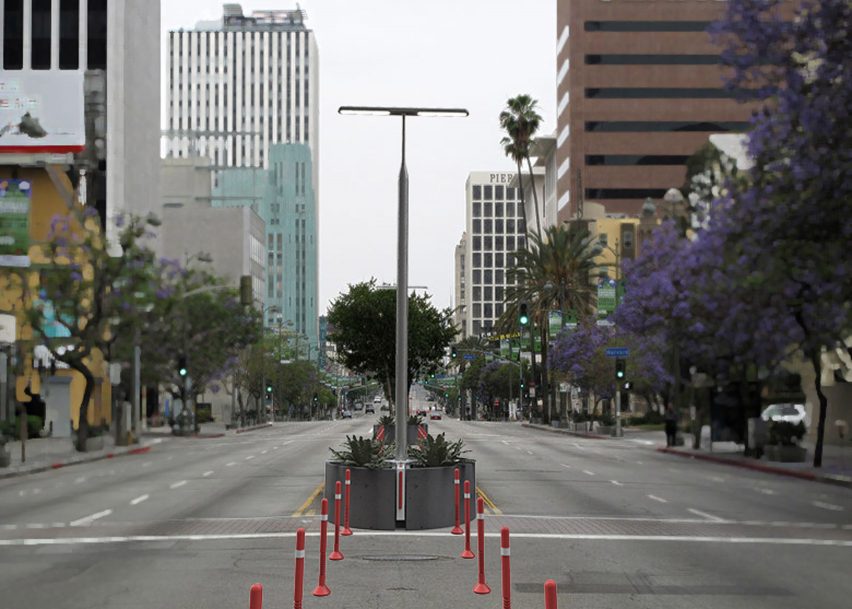A device that turns street lights into floatation devices and a washing machine designed for long-haul truck drivers are among our pick of the best designs presented by graduates from the Middle East at this year's Global Grad Show in Dubai.
Global Grad Show is an exhibition of 150 inventions from the world's leading design and technology schools. Held during Dubai Design Week, from 12 to 17 November 2018, the exhibition features the brightest work from young designers from 100 universities, representing 45 nationalities.
According to exhibition curator Brendan McGetrick, the majority of students this year are "trying to make a positive social or environmental impact".
"It's really focused on innovation in a very broad sense," he said. "We have a lot of projects which are high tech, which are trying to apply technology in particular ways that make human life easier."
"At the same time, we have many projects which are not 'low tech' but are applying design intelligence and design sensitivity to, again, try to give people new abilities and to simply make a positive impact on the world. It's really important to provide design students a platform for that."
Here's our pick of the top projects from the Middle East region:
Naji by Farshad Saffari Ghandehari, Molood Sadat Tavakoli, Hemra Teke, Ali Shahmir Barzoki, Mohammad Amin Kamali Moghadam
A group of industrial design students from the Art University of Isfahan designed a device that turns street lights into floatation devices during floods.
Designed to be easily plugged into existing infrastructure, Naji sits at the base of street lamps and can function as seats on dry days. During severe flooding, the device – made of ethylene vinyl acetate, a highly buoyant material – floats on top of the water surface and can carry multiple people. The device is equipped with belts, so people can sit or hang on it as they await rescue.
Rehber by is a wearable tracking device which can operate without a mobile network.
Although developed at the Royal College of Art, the bracelet is specially designed for pilgrims visiting Mecca during Hajj. With a range of up to five kilometres, the cloud-based system helps families locate their loved ones in a massive crowd – about 2.35 million Muslims participated in 2017 – without the need for a smartphone or phone signal.
Journalist Drone by Sheida Amiri Rigi
Journalist Drone is a modular dash drone and videography platform which allow reporters to customise and build drones according to their needs in the field. It is designed by Sheida Amiri Rigi, an industrial designer from the University of Tehran.
A solo journalist can arrive at a scene and choose the number and combination of drone modules needed to best capture the scale of the event. Viewers then log on a website and choose from different perspectives in real time.
Sustainable Mechanical Pressure Converter for Water Desalination by Shahta AlMarri, Rawdha Alhammadi and Ohoud Alyammahi
Water scarcity is a big issue in the United Arab Emirates, and expensive water desalination facilities provide about 80 per cent of the water consumed in the country. Engineering students from Khalifa University in Abu Dhabi designed a more sustainable device that can transform salt water into fresh water without electricity or fossil fuels.
It uses a hydraulic system that converts wind energy into pressure needed to produce fresh water through membrane desalination.
C Mile by Masoud Sistani and Mohammad Ghasemi
This manual washing machine is designed for long-haul truck drivers.
Industrial design students from the Art University of Isfahan were inspired by the difficulties encountered by truck drivers in Iran – mostly away from home for days at a time, they often wash their clothes in rivers or other bodies of water along the way.
C Mile repurposes the central hub of the truck's wheel, using the empty space as a washtub – the motion of the truck activates the tub's paddles and provides agitation as in a washing machine.
Air Circle by Selami Erdogan
Developed by Selami Erdogan, an industrial designer from Middle East Technical University in Ankara, this medical kit helps low-income families with infants suffering from cystic fibrosis to perform daily chest physiotherapy sessions effectively.
The kit includes a head pillow, a guidance vest – placed on the baby to provide a simple reference for parents administering treatment – and a rhythm device which provides audio guidance on form and duration.
Dyslexia Learning Difficulty by Yara Ahmed Rady
This collection of exercises, created by a product design student at the German University in Cairo, is designed to help children with dyslexia learn Arabic.
The toolkit offers alternative routes to literacy, transforming conventional teaching techniques into games. It engages all five senses to achieve a more holistic approach to Arab language instruction.
Circuit Chair by Maryam Alhammadi and Khawla Alsuwaidi
Circuit Chair is a multifunctional furniture piece with combined seating, shelving and storage capabilities. It can be rotated in different directions and is made with two kinds of wood.
Specially designed to be placed in a library, the furniture piece, created by two young interior designers from Zayed University, takes its cues from an electrical circuit, connecting activities, materials and forms to create a single space-efficient piece.

